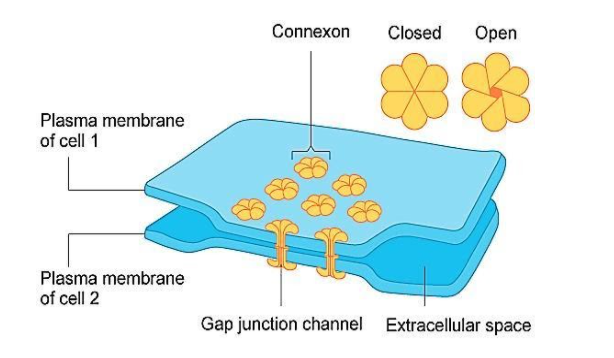
The function of gap junction is to
A. Cementing to keep neighboring cells together
B. Facilitate communication between adjoining cells by connecting their cytoplasm for rapid transfer of ions, small molecules and some large molecules.
C. Separate two cells from each other.
D. Stop substances from leaking across a tissue.
Answer
570.3k+ views
Hint: Gap junctions are only found in animal cells and their role resembles that of plasmodesmata present in plants. They are specialized intercellular connections between different types of cells.
Complete answer:
Gap junctions are known for connecting different types of cells through channels of protein. They connect the cytoplasm of adjacent cells, thereby, allowing the exchange of ions, small molecules, and large molecules. These junctions are found between those cells that are in direct contact with each other. The correct answer will be that the function of gap junctions is to facilitate communication between adjoining cells by connecting their cytoplasm for rapid transfer of ions, small molecules, and some large molecules.

Adherens junctions are those junctions which are meant for cementing to keep neighboring cells together. This adherence is always calcium-dependent. So, option (A) is incorrect.
The role of gap junctions is to connect two adjacent cells but not to separate them. So, option (C) is not correct.
Tight junctions are known for creating a watertight seal between two cells thereby stopping substances from leaking across a tissue. The proteins called claudins present in tight junctions are known for holding two cells against each other. Option (D) is also incorrect.
Hence, the correct option is (B).
Note: Gap junctions in animal cells are known for the cytoplasmic exchange between adjacent cells as they connect two adjacent cells through protein channels. These channels allow the passage of ions, small and large molecules.
Complete answer:
Gap junctions are known for connecting different types of cells through channels of protein. They connect the cytoplasm of adjacent cells, thereby, allowing the exchange of ions, small molecules, and large molecules. These junctions are found between those cells that are in direct contact with each other. The correct answer will be that the function of gap junctions is to facilitate communication between adjoining cells by connecting their cytoplasm for rapid transfer of ions, small molecules, and some large molecules.

Adherens junctions are those junctions which are meant for cementing to keep neighboring cells together. This adherence is always calcium-dependent. So, option (A) is incorrect.
The role of gap junctions is to connect two adjacent cells but not to separate them. So, option (C) is not correct.
Tight junctions are known for creating a watertight seal between two cells thereby stopping substances from leaking across a tissue. The proteins called claudins present in tight junctions are known for holding two cells against each other. Option (D) is also incorrect.
Hence, the correct option is (B).
Note: Gap junctions in animal cells are known for the cytoplasmic exchange between adjacent cells as they connect two adjacent cells through protein channels. These channels allow the passage of ions, small and large molecules.
Recently Updated Pages
Master Class 12 Business Studies: Engaging Questions & Answers for Success

Master Class 12 Economics: Engaging Questions & Answers for Success

Master Class 12 English: Engaging Questions & Answers for Success

Master Class 12 Maths: Engaging Questions & Answers for Success

Master Class 12 Social Science: Engaging Questions & Answers for Success

Master Class 12 Chemistry: Engaging Questions & Answers for Success

Trending doubts
What are the major means of transport Explain each class 12 social science CBSE

Which are the Top 10 Largest Countries of the World?

Draw a labelled sketch of the human eye class 12 physics CBSE

Explain sex determination in humans with line diag class 12 biology CBSE

The pH of the pancreatic juice is A 64 B 86 C 120 D class 12 biology CBSE

Explain sex determination in humans with the help of class 12 biology CBSE




